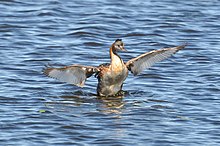Magellan diver
| Magellan diver | ||||||||||
|---|---|---|---|---|---|---|---|---|---|---|

Magellan divers in Rio Grande do Sul , Brazil |
||||||||||
| Systematics | ||||||||||
|
||||||||||
| Scientific name | ||||||||||
| Podiceps major | ||||||||||
| ( Boddaert , 1783) |
The Magellan divers ( Podiceps major , english great grebe ; spanish Somormujo macachón ) is the largest species of grebe worldwide. There is a disjoint population with distribution areas in northwestern Peru on the one hand and the main distribution area in the extreme southeast from Brazil to Patagonia and central Chile on the other. The population in southern Chile is considered a separate subspecies, Podiceps major navasi .
features
The proportions of the magellan diver are more reminiscent of a goose or a cormorant than a typical diver . It usually becomes 67–80 cm long and weighs 1,600 g, but can weigh up to 2 kg. The plumage is bloody red on the neck and chest, black on the back and whitish on the belly. The head plumage is soot-gray with a reddish-brown eye. Because of its size and unique coloration, the magellan diver is unmistakable.
habitat
The species lives mainly in open waters. Most birds live in lakes at low altitudes and slow-flowing rivers, often in forest areas, on and in estuaries . During the breeding season, the birds often come to the densely overgrown bays of larger lakes. Outside of the breeding season, most of the animals live in estuaries and bays, especially in the area of extensive kelp forests . Non-breeding birds live on the coast all year round.
The birds are widespread and often within their range. In many places, especially in the southern part of the distribution area, the environment is still natural.
Way of life
food
The magellan diver feeds mainly on fish, with sizes up to 11 cm in length. Occasionally there is food competition with olive shags , whereby this species usually prey on larger fish - despite smaller body dimensions. Insects, crustaceans and mollusks are also preyed on. In winter, up to half the food on the coast can consist of crabs . Occasionally, juveniles from other waterfowl are also captured, mostly by coots .
Breeding behavior
The birds live in large groups outside of the breeding season. They move inland during the breeding season. Most animals breed between October and January, with the breeding season moving back the further south you go. In the isolated population in Peru , nesting begins as early as September or October and in good years there is a second brood in January or February. The species is relatively social in the breeding season, occasionally small colonies form. Three to five eggs form a clutch, often two broods are raised at the same time.
Subspecies
- P. m. major ( Boddaert , 1783) , West Peru , Paraguay , Southeast Brazil , Uruguay , Central Chile & South Argentina
- P. m. navasi (Manghi, 1984) , southern Chile
literature
- Elliott & Sargatal del Hoyo: Handbook of Birds of the World. Vol. 1; Ostrich to Ducks, ISBN 84-87334-10-5
Single receipts
- ^ F. Llimona, J. del Hoyo, F. Jutglar, GM Kirwan: Great Grebe (Podiceps major) . In: J. del Hoyo, A. Elliott, J. Sargatal, DA Christie, E. de Juana (Eds.): Handbook of the Birds of the World Alive . Lynx Edicions , Barcelona 2019 (English, hbw.com [accessed February 21, 2019]).
- ↑ Great Grebe (Podiceps major) . In: TS Schulenberg (Ed.): Neotropical Birds Online . Cornell Lab of Ornithology, Ithaca, NY ( cornell.edu [accessed February 21, 2019]).
Web links
- BirdLife International: Podiceps major, Great Grebe . In: IUCN (Ed.): The IUCN Red List of Threatened Species . 2016, e.T22696596A93573021 , doi : 10.2305 / IUCN.UK.2016-3.RLTS.T22696596A93573021.en (English, iucnredlist.org [accessed February 21, 2019]).
- Magellan diver, Podiceps major. In: Avibase. Denis Lepage, accessed February 21, 2019 .
- BirdLife International: Species factsheet: Podiceps major. In: birdlife.org. 2019, accessed on February 21, 2019 .
- Podiceps major. In: Integrated Taxonomic Information System. 2019, accessed on February 21, 2019 .
